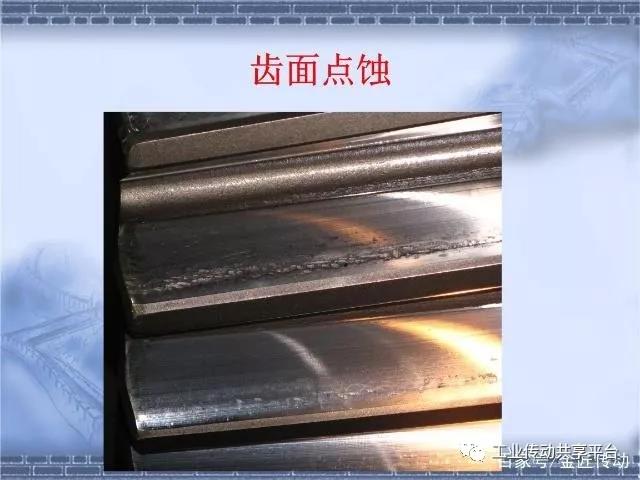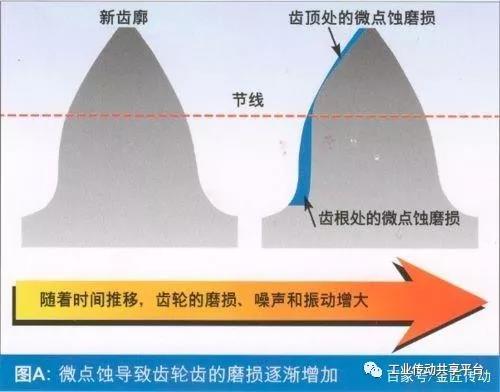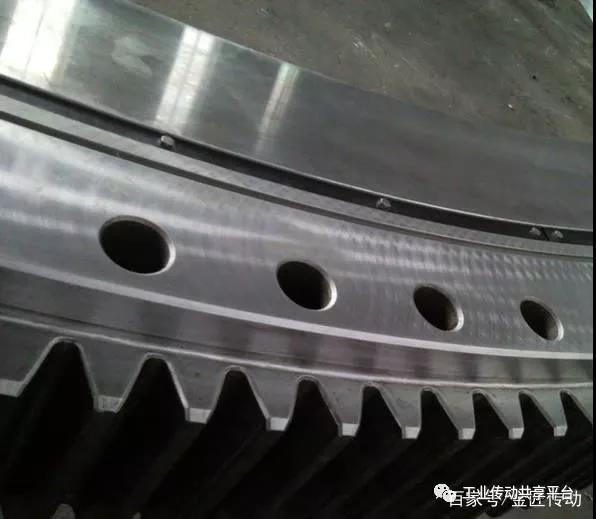The most common form of damage to the reducer during use.It is an important part of the mixer. The gear is the heart of the reducer. Gear damage is one of the main reasons for the failure of the reducer. The forms of gear damage include: tooth surface pitting, tooth fracture, tooth surface wear, tooth surface gluing and tooth surface Plastic flow, etc.During the use of the reducer, gear pitting is the most common form of damage to the reducer. Severe pitting of the reducer gear will cause large vibrations in the operation of the equipment, increase in oil temperature, and aggravate bearing wear, and even the use of the reducer for 2-3 years It needs to be overhauled.Through the 2016 annual maintenance statistics of Shigaoma reducer of the division.It can be seen that for Shicoma mixer reducer, pitting on the tooth surface is the most common form of damage to the reducer during use.

1 Gear pitting mechanism
1.1 The concept of pitting corrosion
When a pair of gears mesh, a cyclically changing contact stress occurs between the two tooth surfaces (see Figure 1). If this contact stress exceeds the contact fatigue limit of the tooth surface material, the gear will work for a certain period of time. Microscopic fatigue cracks will appear inside the surface layer. With the propagation and expansion of this crack, the metal surface of the tooth surface will peel off and form pits (see Figure 2). This phenomenon is called pitting [1].When pitting corrosion occurs, the bearing area of the tooth surface decreases rapidly, and the contact stress increases sharply, which not only intensifies the fatigue damage of the tooth surface, but also destroys the correctness of the tooth surface meshing, causing considerable dynamic load, and finally Causes large pieces of gear tooth flanks to peel off and be scrapped.
1.2 Mechanism and process of pitting corrosion
Pitting corrosion of tooth surface is a kind of surface fatigue wear, which refers to the result of cracks and micro-chips separated and broken on the declining surface of the gear when the gear is meshed under the action of alternating stress.According to Krazhanriski’s wear fatigue theory, the basic mechanism of pitting corrosion is: due to the existence of surface roughness and waviness, the surface contact of the two tooth surfaces is discontinuous; wear is due to the local deformation and localization of the actual contact area. The process of material mechanical failure due to stress; the material fatigue failure of certain parts of the friction surface will depend on the alternating load borne by the contact area.The pitting process is composed of three stages of development.One is the interaction of the surfaces; the second is the change in the properties of the surface layer of the contact material under the influence of friction; the third is the destruction of the surface and the shedding of abrasion particles.Surface interaction is the most important stage of these three development stages. At the same time, the dual nature of interaction and the discontinuity of contact must be considered.

2 Causes of pitting and countermeasures
2.1 The influence of reducer manufacturing and assembly accuracy
One of the reasons for the early pitting corrosion of the reducer is due to the low assembly accuracy, which reduces the contact area of the gear and the local overload, so that the actual contact stress greatly exceeds the allowable contact stress of the gear material. This is because the two center lines of the gear pair are different. It is caused by too large parallel or cross deviation and too large tooth direction error during gear processing.The improper selection of gear materials and heat treatment hardness results in low tooth surface hardness, which cannot meet the operating needs, and is also an important cause of pitting corrosion.
2.2 The influence of installation accuracy
After the reducer and the motor are installed, the shaft alignment does not meet the requirements of the specification, causing the motor coupling and the reducer input coupling to be misaligned, causing uneven force on the input gear of the reducer, and overloading of the transmission gear on one side. Causes pitting on the tooth surface, causing damage to the reducer gear.
2.3 Influence of load
There are two main sources of load for the reducer of mixing equipment: one is the load mainly from mixing and blade load. Excessive medium density and high liquid level in the kettle will increase the mixing load and cause gear pitting; the second is the drive shaft The system vibration causes the load to increase. Due to the increase of the clearance between the bearing and the bearing hole, the rigidity of the transmission bearing, etc., it causes abnormal vibration of the shaft system and produces pitting on the tooth surface.
2.4 The influence of lubricating oil
Lubricating oil can reduce the wear and tear in the mechanical transmission, damping and lubricate, and improve the expected life of the equipment.Therefore, in daily gear maintenance, creating good lubrication conditions and using reasonable lubrication techniques to reduce and reduce gear tooth surface pitting wear and other damage is a topic that on-site technicians must pay attention to [3].
2.4.1 The influence of lubricating oil quality
The primary condition for gear pitting on the tooth surface is microcracks.Then in the course of work, the load was repeated many times, and the cracks continued to expand, resulting in pitting corrosion.The source of cracks is caused by mechanical processing on the surface, or the material structure is not uniform (there are slag inclusions, pores, hard particles, etc.) and local shear stress is too large, which occurs on the surface (under the surface). The source of cracks is repeatedly loaded and cracks Gradually be pulled apart, so as to extend to the surface and fall off.The viscosity of lubricating oil has a great influence on pitting corrosion. Thin lubricating oil is easier to penetrate into cracks than viscous lubricating oil during work, causing cracks to grow. Lubricating oil with high viscosity has strong cushioning and vibration absorption and strong bearing capacity. .High-viscosity lubricating oil can reduce the impact.Delay the propagation of cracks and enhance the pitting resistance of gears.If low-viscosity lubricating oil is added, it is very easy to cause pitting of the reducer gear.In production and use, water in the reducer case often causes lubricating oil emulsification. It is found that the main source of water in the reducer is the damage of the oil seal at the input end of the reducer. Water enters the gear box along the input shaft of the reducer, causing the emulsification and deterioration of the lubricating oil.Reduce the viscosity of the lubricating oil, reduce the load-bearing capacity, and cause pitting on the tooth surface.
2.4.2 Influence of additives
The addition of a certain proportion of oiliness agents and extreme pressure additives to the lubricating oil will reduce friction, increase the strength of the boundary oil film, and improve the pitting resistance of the gear.However, some additives contain corrosive substances, which can cause the metal tooth surface to rust and cause cracks; the presence of air bubbles in the additive can also cause pitting and wear off the tooth surface.
2.4.3 The influence of oil temperature
Too high oil temperature will reduce the viscosity of the lubricating oil, which is not conducive to the formation of the oil film between the gear tooth surfaces. The lubricating film on the gear meshing surface becomes thinner, the load bearing and anti-wear ability of the tooth surface decreases, and pitting occurs.
3 Measures to reduce pitting corrosion
(1) When selecting the gear reducer, select the appropriate gear material and heat treatment hardness according to the use load of the equipment. Professional technicians will supervise the assembly of the gear reducer to ensure gear installation accuracy and gear contact accuracy, thereby reducing Pitting.
(2) When the stirring shaft is installed, strictly control the leveling of the stirring tank frame and the plumbness and runout of the stirring shaft, plumbness <L / 1000, runout <5mm, reduce the runout and uneven load of the stirring system .
(3) The reducer and the motor are installed in sections. The reducer and the motor, the reducer and the driven equipment are in strict accordance with the "General Specification for Construction and Acceptance of Mechanical Equipment Installation Engineering" GB50231. More than 0mm, to ensure the accuracy of the reducer installation.
(4) For the mixing reducer, reasonably control the amount of glue sprayed, control the density of the material in the kettle, stabilize the liquid level in the kettle, reduce the load and reduce the rate of change of the alternating load, thereby reducing gear pitting.
(5) Reasonably choose the material of the bottom bearing and the middle bearing, change the previous tin bronze and tetrafluoroethylene material to tetrafluoroethylene + nylon, reduce the wear of the bearing and the stirring shaft, and repair the bearing and the gap between the bearing and the bearing seat in time. Reduce the load of the reducer due to vibration, so as to extend the service life of the gear.
(6) Choose lubricating oil with suitable viscosity, check the oil quality regularly, and replace it in time when there is a problem.The connection between the motor and the reducer and the oil seal gland of the input shaft of the reducer are added with sealant to prevent rainwater from entering.
(7) The mixing reducer uses circulating water for cooling. The calcification in the circulating water will deposit in the inner cooling tube, causing poor heat transfer between the inner cooling tube and the heat exchanger, and even clogging, causing the lubricating oil temperature to be too high. Therefore, it should be checked regularly. The inner cooling tube of the reducer is chemically cleaned to ensure the heat removal effect of the inner cooling tube and avoid the pitting of the reducer gear caused by the increase in temperature.
(8) After selecting the appropriate lubricant for the reducer, some anti-wear and pressure-resistant additives can be properly mixed in proportion to enhance the lubrication effect of the reducer gear and reduce the pitting corrosion of the gear.

4 Conclusion
There are many factors influencing the pitting corrosion of the gears of Sgaoma reducer, which are not only related to the manufacturing accuracy of the reducer itself, gear material, and hardness ratio, but also to the installation accuracy of the reducer and mixing system, load distribution and cooling and lubrication. close relationship.Therefore, in terms of equipment installation and maintenance of the reducer in the future, improvements will be made in strict accordance with the above measures to reduce the degree of pitting of the reducer gear and prolong the service life of the reducer.